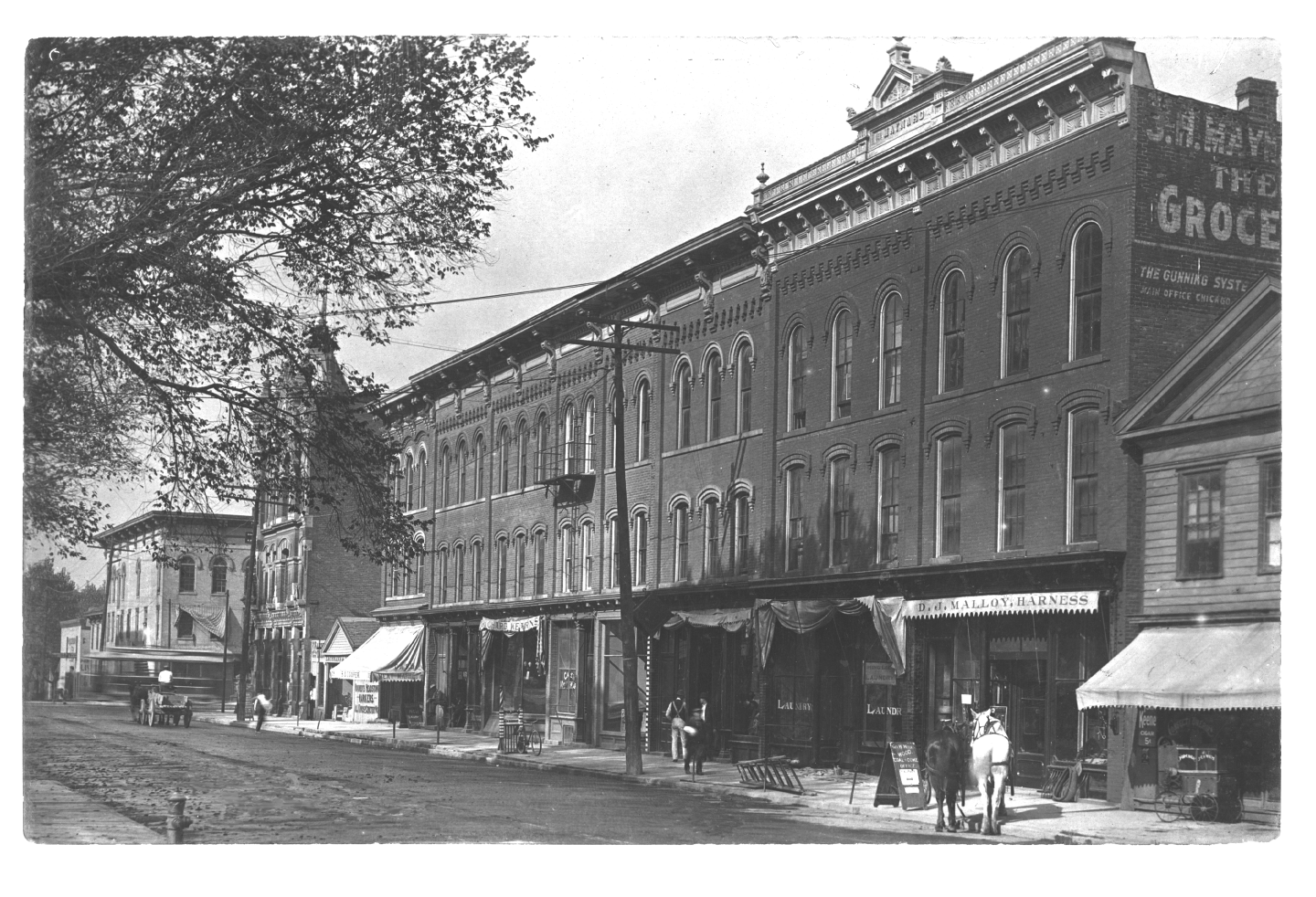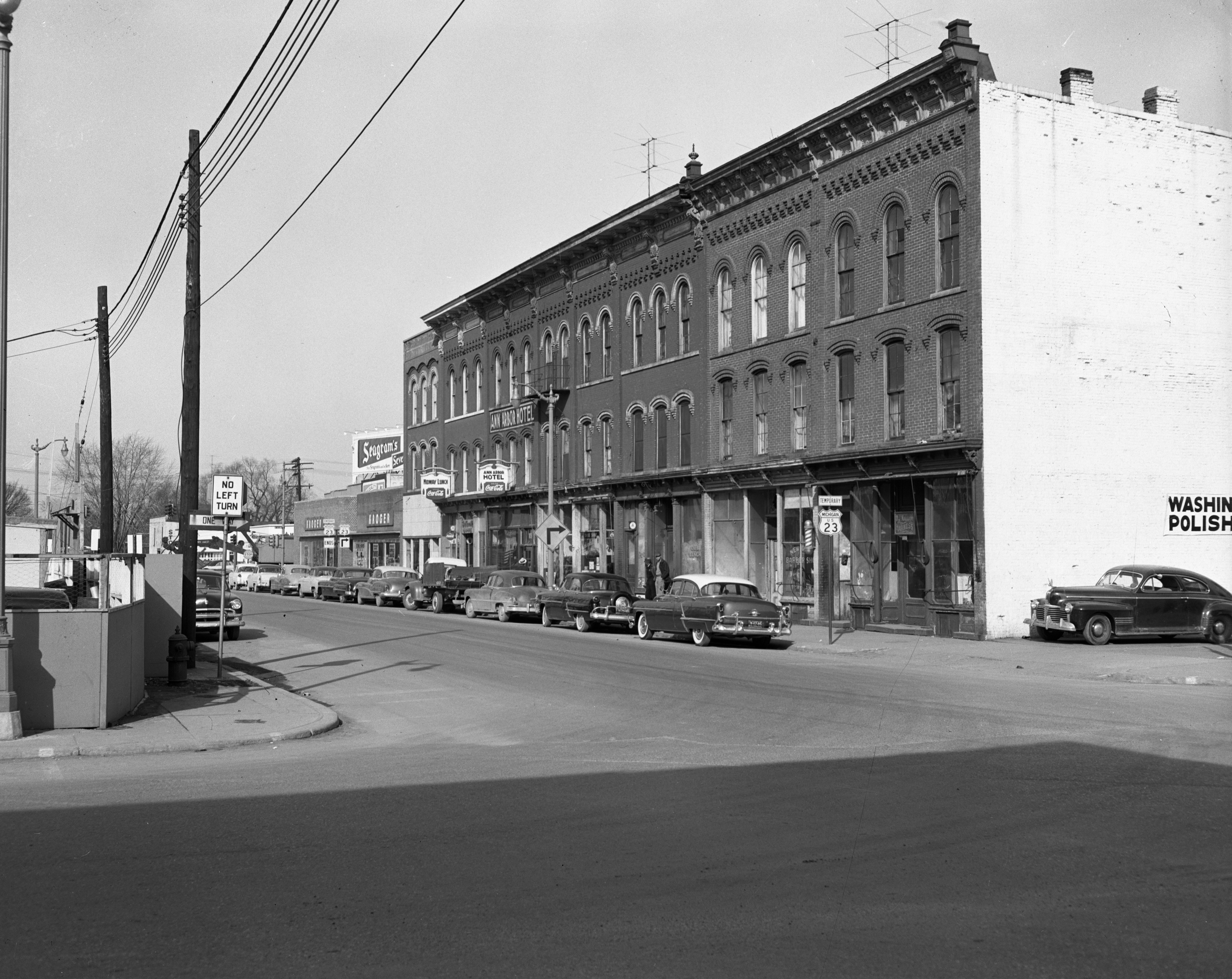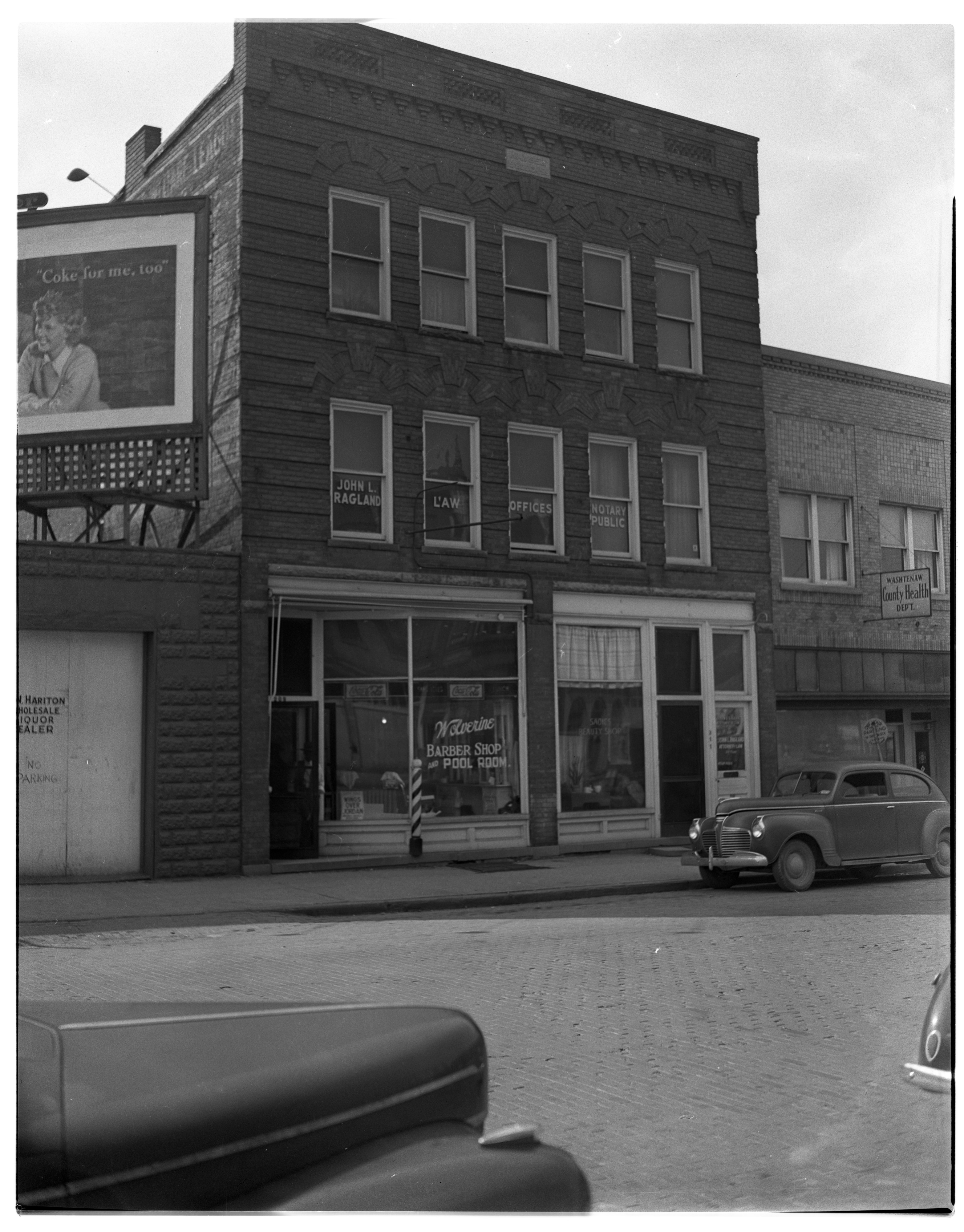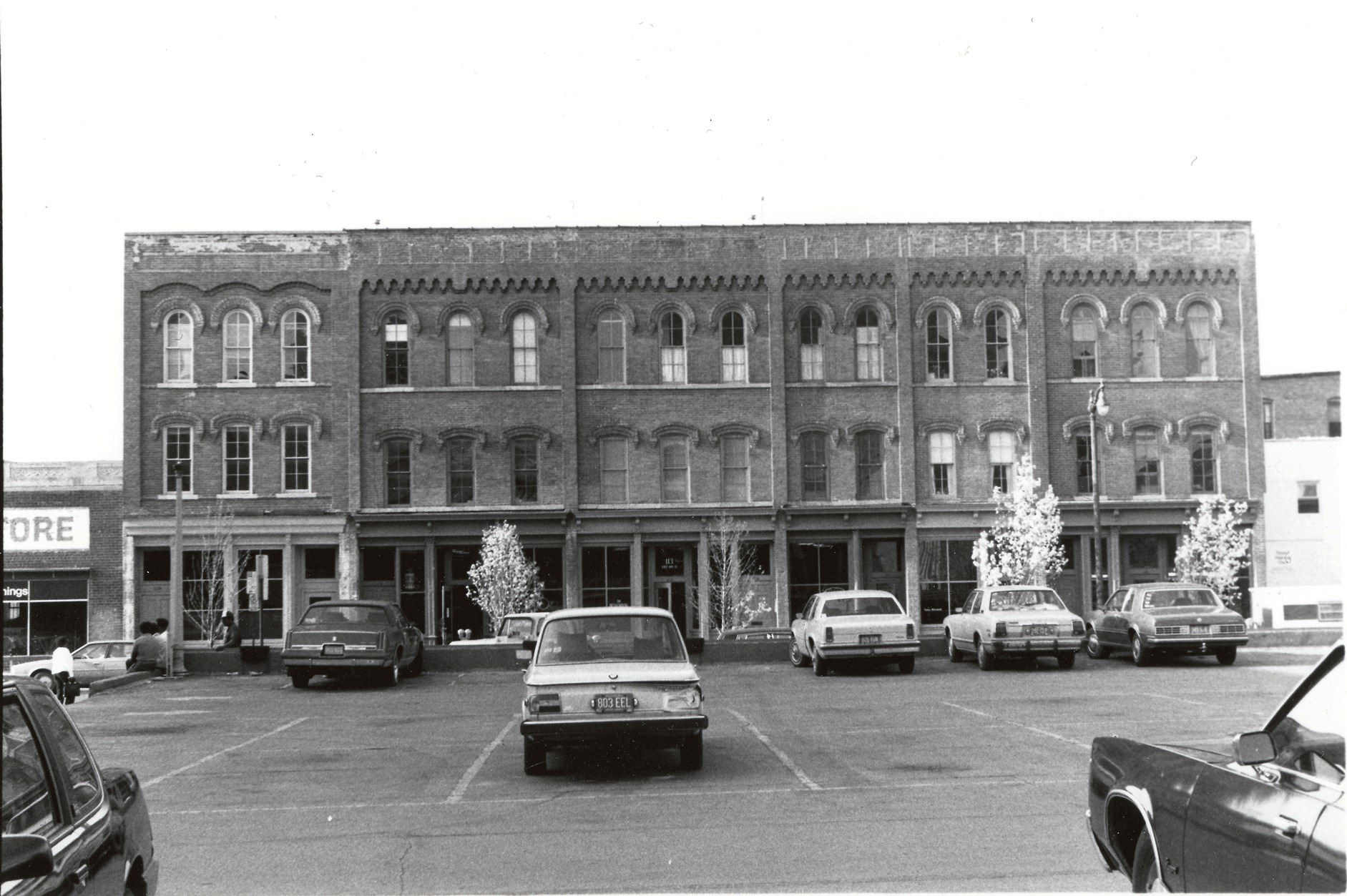Ann Street Black Business District
For most of the twentieth century, the 100 block of East Ann Street was a hub for Black-owned businesses in downtown Ann Arbor. A rotating set of barber shops, shoe shine parlors, dry cleaners, restaurants, blues bars, and pool rooms formed the backbone of Black social life, especially for men. The district stretched around the corner onto North Fourth Avenue where the Colored Welfare League housed Black-owned businesses and community organizations such as the early Dunbar Center. The area had a long history of billiards and gambling stretching back into the nineteenth century, but by the 1970s Ann Street had established a tougher reputation for drug trafficking. A series of violent crimes and police crackdowns led to the closure of many Black-owned businesses. Subsequent building restorations and renovations brought on a new wave of small businesses with little connection to the block’s historical character.
Early Days, 1871-1930
 Most accounts of Black businesses in Ann Arbor begin with Henry Wade Robbins, a barber who moved to the area in the 1890s and purchased his own shop at 117 E Ann Street in 1915. Born in Chatham, Ontario to descendants of former slaves, Robbins was a model success story for the promotional volume Michigan Manual of Freedmen’s Progress. But he died only a year later, leaving his property to his second wife Martha and two children, David and Alice. Although Martha Robbins sold the Hoban Block to white restaurateur Christ Bilakos in 1937, Ann Street continued to flourish as a center of Black commerce and social life for several decades.
Most accounts of Black businesses in Ann Arbor begin with Henry Wade Robbins, a barber who moved to the area in the 1890s and purchased his own shop at 117 E Ann Street in 1915. Born in Chatham, Ontario to descendants of former slaves, Robbins was a model success story for the promotional volume Michigan Manual of Freedmen’s Progress. But he died only a year later, leaving his property to his second wife Martha and two children, David and Alice. Although Martha Robbins sold the Hoban Block to white restaurateur Christ Bilakos in 1937, Ann Street continued to flourish as a center of Black commerce and social life for several decades.
Robbins’ career built on the success of a number of Black barbers operating in the area since at least the 1870s. His predecessors included fashionable MiCagy Shewcraft, who ran M.C. Shewcraft’s Shaving Palace, and Civil War veteran Jerome A. Freeman, proprietor of Postoffice Barber Shop and Bath. An 1879 Michigan Argus article described Shewcraft’s employees as “six colored knights of the strop [who] wield the razor and shears.” Freeman’s barber shop was located on the second floor of the ornate Beal Block, on the corner of Main Street and E Ann Street. The Beal Block housed the Post Office and operated as the informal social center of the city.
Another hub of early Black-owned businesses in Ann Arbor was the Kayser Block, which was built at 209-211 North Fourth Avenue in 1899. After a brief stint as the Newman Hotel, the hotel came under African American ownership. Most famous of these owners was heavyweight champion Hank Griffin, who opened Griffin Hotel in 1907 (as well as a local boxing gym).
By World War I, the African American community in Ann Arbor was growing, and it was becoming difficult for newcomers and migrant workers to find housing. Community leaders used leftover funds raised from send-off parties for Black WWI soldiers for a downpayment to purchase the Kayser Block for the Colored Welfare League in 1921. The League rented out rooms to boarders and storefronts to businesses such as Samuel Elliott’s barber shop and James A. Moore’s restaurant. It also housed important community organizations like the Dunbar Center.
Rise of the Black Business District, 1930-1960
 In the early decades of the twentieth century, many of the grocery stores, meat markets, and saloons on the 100 block of E Ann Street were owned by Greek immigrants, while Black-owned businesses were clustered at either end of the block. But the opening of popular establishments such as Sanford’s Shoe Repair and Easley’s Barber Shop in the 1930s solidified the block’s reputation as Ann Arbor’s Black business district.
In the early decades of the twentieth century, many of the grocery stores, meat markets, and saloons on the 100 block of E Ann Street were owned by Greek immigrants, while Black-owned businesses were clustered at either end of the block. But the opening of popular establishments such as Sanford’s Shoe Repair and Easley’s Barber Shop in the 1930s solidified the block’s reputation as Ann Arbor’s Black business district.
Sanford McKinney and John B. Easley were both longtime proprietors; their shops remained on the block well into the 1960s, and their careers offer snapshots of mid-century life on Ann Street. McKinney, a well-respected Masonic leader, first opened his shoe shine business in the same building as Hing Lee Laundry, a Chinese-owned business in operation since 1894. Cooperative arrangements such as these were common. Easley, on the other hand, had a reputation for gambling. Nicknamed “Papa John,” he was arrested at least once on charges of operating a gambling place out of his shop in the early 1960s. One local resident recalled that Easley, in addition to being a perfect gentleman in front of ladies and children, “could have starred in any movie about black gangsters. He was athletically built and always wore a spotless white shirt. He spoke with a heavy voice, which suggested, ‘I am in control,’ every time it was heard.”
Some barber shops and pool rooms in the district did participate in underground gambling. Police turned a blind eye until 1946, when a highly publicized trial resulted in the resignation of Chief of Police Sherman H. Mortenson due to accusations of bribery. Witnesses in the trial included pool hall owner George Whitman and barbers Easley and Elliott.
Black Ann Arbor residents who grew up in the 1940s and 50s remember visiting Ann Street and Fourth Avenue for food, entertainment, and community. One of the most popular fixtures was Midway Lunch, a restaurant run by David and Mozelle Keaton at 111 E Ann St, and a neighboring pool hall that changed hands a few times before it became Keaton’s Recreation Hall in the early 1950s. In interviews recorded as part of the African American Cultural and Historical Museum’s Living Oral History Project, local residents offer first-hand accounts. Willis Patterson describes “a small little greasy spoon” run by Marion Pressley in the late 1940s. James Anderson remembers that his mother worked in Myrtle’s Beauty Shop, just above Whitman’s Pool Hall.
Around the corner at 209-211 N Fourth Ave, the Colored Welfare League continued to house Black-owned businesses such as John L. Ragland’s law offices, Wolverine Barber Shop and Pool Room, Sadie’s Beauty Shop, and Julia’s Tea Room.
Blues Bars and “The Block,” 1960-1977
By 1960, the businesses on Ann Street had shifted towards entertainment. Bars and pool rooms dominated the district, including popular blues bars such as The Derby Bar and Clint’s Club. AACHM Living Oral History Project participant Shirley Beckley remembers that she and her friends “weren’t allowed on Ann Street” as teenagers, but that she went to the bars as a young adult.
During this era, Ann Street was known to police officers as “the Block” because of the crime rate. Stanley W. Carras' Derby Bar, with its trendy R&B and soul music, was a community hangout for a younger generation. But it also became a hub for drug trafficking and related violence. Next door at Clint’s Club, an older crowd listened to the blues. Ann Arbor's white blues band The Prime Movers played there regularly in 1966 and 1967, and attracted a racially mixed audience.
Former Ann Arbor City Councilman Larry Hunter recalls that a blind pig operated in the basement of Clint’s Club, where he spent weekends shooting pool to earn money for tuition. “They called me ‘college boy’ because I was taking all the old men's money…. I learned the good and the bad and the ugly from these old guys.”
 At the same time as the bars, pool halls, and barber shops anchored Black social life in the Ann Street district, the rise of drug-related violence and police crackdowns led to its end. In 1976, after sixteen years of operating his barber shop on Ann Street, Johnnie Rush left the district for a more family-friendly area. Rush describes the tipping point: “I was cutting hair one day in my shop. And I let two guys come in and use my restroom. And they got back there, and got to tussling over the guns. And the gun went off. And that bullet ricocheted back up over near where I was cutting hair. And my own uncle jumped up, and said, ‘Well, you is in the family. But I can't be coming down here.’”
At the same time as the bars, pool halls, and barber shops anchored Black social life in the Ann Street district, the rise of drug-related violence and police crackdowns led to its end. In 1976, after sixteen years of operating his barber shop on Ann Street, Johnnie Rush left the district for a more family-friendly area. Rush describes the tipping point: “I was cutting hair one day in my shop. And I let two guys come in and use my restroom. And they got back there, and got to tussling over the guns. And the gun went off. And that bullet ricocheted back up over near where I was cutting hair. And my own uncle jumped up, and said, ‘Well, you is in the family. But I can't be coming down here.’”
By June 1977, all of the storefronts on the 100 block of E Ann Street were closed and boarded up. But around the corner on N Fourth Ave, former WWII barber J. D. Hall settled in for the long haul. When the Colored Welfare League sold the Kayser Block in 1966, Hall decided to invest in it to preserve the legacy of the district. Hall brought the building up to code and opened Hall's Barber Shop. In 1983, his sister Lucille Hall Porter established the Community Leaning Post, a nonprofit organization for homeless ex-prisoners and disadvantaged youth. During Hall’s ownership, the building also hosted community organizations such as Model Cities and the Women’s Crisis Center.
A Changing Neighborhood, 1977-Present
 The departure of longtime business owners like Johnnie Rush and the closure of fixtures such as The Derby Bar marked the end of an era on Ann Street. Property owners Peter Bilakos, Olga Bilakos, and Christina Farmasonis, who inherited the Hoban Block from their father, decided to renovate the building to restore its historical character. Built in 1871 after a fire destroyed the previous buildings, the block features Italianate brick facades with arched windows and brick corbeling. The Bilakos’ renovation in the late 1970s restored the storefronts and transformed the upper stories into contemporary townhouses.
The departure of longtime business owners like Johnnie Rush and the closure of fixtures such as The Derby Bar marked the end of an era on Ann Street. Property owners Peter Bilakos, Olga Bilakos, and Christina Farmasonis, who inherited the Hoban Block from their father, decided to renovate the building to restore its historical character. Built in 1871 after a fire destroyed the previous buildings, the block features Italianate brick facades with arched windows and brick corbeling. The Bilakos’ renovation in the late 1970s restored the storefronts and transformed the upper stories into contemporary townhouses.
In the 1980s, a new wave of small businesses with little connection to Ann Street’s history as the center of the Black business district populated the renovated building. Peter Bilakos’ law office, a bicycle shop, a book bindery, and an architect’s office replaced blues bars, barber shops, and pool halls. Around the corner on N Fourth Ave, the former Colored Welfare League building continued to be a focal point of the Black community until J.D. Hall’s death and the closure of his barber shop in 1999.
List of Black-Owned Businesses in the Ann Street District
| Business Name or Type | Date | Address | Proprietor |
|---|---|---|---|
| M.C. Shewcraft’s Shaving Palace | c. 1879-1882 | 3 doors east of post office | MiCagy Shewcraft |
| Mrs. Shewcraft’s Barber Shop | c.1887-1904 | 110 N Fourth | Elizabeth A. Shewcraft |
| Postoffice Barber Shop & Bath | c.1888-1894 | 103 E Ann | Jerome A. Freeman |
| Barber Shop | c.1895-1897 | 31 N Main St | Henry Wade Robbins |
| Barber Shop | c.1898-1908 | 217 N Main | Henry Wade Robbins |
| Barber Shop | c.1908-1910 | 205 N Main | Henry Wade Robbins |
| Griffin Hotel | c.1907-1911 | 209-211 N Fourth | Henry (Hank) Griffin |
| Barber Shop | 1910 | 117 E Ann | William S. Brown |
| Pool Hall | 1911-1912 | 111 E Ann | Jacob A. Becks |
| Barber Shop | 1911-1916 | 117 E Ann | Henry Wade Robbins |
| Hotel | 1912 | 209-211 N Fourth | Laura Price |
| Hotel | 1913-1916 | 209-211 N Fourth | Herbert Case and Jacob A. Becks |
| Restaurant | 1915 | 119 E Ann | Noah B. Fort |
| Hotel | 1917 | 209-211 N Fourth | Jacob A. Becks and Albert Robinson |
| Barber Shop | 1917 | 117 E Ann St | James A. Moore and William P. Roper |
| Barber Shop | 1918 | 117 E Ann | James A. Moore |
| Barber Shop | 1920 | 111 E Ann | James A. Moore |
| Colored Welfare League | 1921-1966 | 209-211 N Fourth | Rev. Ralph M. Gilbert |
| Barber Shop | 1922-1926 | 109 E Ann | James A. Moore |
| Dunbar Civic Center | 1923-1926 | 209-211 N Fourth | Rev. Ralph M. Gilbert |
| Barber Shop | 1927-1928 | 109 E Ann | William P. Roper |
| Restaurant | 1927-1932 | 209 N Fourth Ave | James A. Moore |
| Barber Shop | 1927-1932 | 211 N Fourth Ave | Samuel Elliott |
| Shoe Shine | 1928-1939 | 119 E Ann | Sanford McKinney |
| Barber Shop | 1929 | 109 E Ann | John B. Easley |
| Ever-Ready Beauty Parlor | 1930-1932 | 211 N Fourth | |
| Billiards | 1930-1932 | 109 E Ann | James A. Moore |
| Wolverine Barber Shop and Pool Room | 1930-1936 | 109 E Ann | John D. Riggs |
| Clara’s Dining Room | 1934-1938 | 209 N Fourth | |
| Billiards | 1934-1952 | 119 E Ann | George Whitman |
| Easley’s Barber Shop | 1934-1958 | 115 E Ann | John B. Easley |
| Charlotte’s Beauty Shop | 1935-1942 | 211 N Fourth | |
| Josephine’s Tea Room | 1937-1938 | 211 N Fourth | Josephine Williams |
| Wolverine Barber Shop and Pool Room | 1937-1938 | 109 E Ann | Samuel Elliott |
| Myrtle’s Beauty Shop | 1937-1956 | 119½ E Ann | Myrtle Whitman |
| Julia’s Tea Room | 1939-1943 | 211 N Fourth | Julia Smith |
| Wolverine Barber Shop and Pool Room | 1939-1945 | 209 N Fourth | Samuel Elliott |
| Sanford’s Shoe Repair | 1940-1956 | 117 E Ann | Sanford McKinney |
| John L. Ragland, Attorney at Law | c.1941-1952 | 211 N Fourth | John L. Ragland |
| Midway Lunch | 1941-1962 | 111 E Ann | David Keaton |
| Sadie’s Beauty Shop | 1943-1960 | 211 N Fourth | Sadie Harmon |
| Edwards Bros Hi-Speed Service Station | c. 1947 | 201 N Fourth | Horace R. Edwards and George M. Edwards |
| Bon-Ton Grill | c.1947-1951 | 121 E Ann | Marion Pressley |
| New Deal Barber Shop | 1952-1955 | 121 E Ann | William Marney |
| Keaton’s Recreation Hall | c.1952-1974 | 109 E Ann | David Keaton |
| Pelly Bullock Cleaners | c.1955-1967 | 209 N Fourth | Pelly Bullock |
| New Deal Barber Shop | 1956-1958 | 209 N Fourth | William Marney |
| Sanford’s Shoe Repair | 1957-1962 | 119 E Ann | Sanford McKinney |
| Easley’s Barber Shop | 1960-1962 | 117 E Ann | John B. Easley |
| Esquire Barber Shop | 1961-1963 | 123 E Ann | Johnnie Rush |
| Fourth Ave Barber Shop | 1962-1967 | 211 N Fourth | |
| Mid-Way Bar | 1963-1965 | 111 E Ann | David Keaton |
| Sanford’s Shoe Repair | 1963-1965 | 117 E Ann | Sanford McKinney |
| Johnnie Rush Barber Shop | 1964 | 123 E Ann | Johnnie Rush |
| Johnnie Rush Barber Shop | 1965-1976 | 115 E Ann | Johnnie Rush |
| Pelly Bullock Cleaners | 1968-1971 | 117 E Ann | Pelly Bullock |
| Hall’s Barber Shop | 1968-1981 | 209 N Fourth | James Donald (J. D.) Hall |
| Rosey’s Hair Styling Den | 1968-1981 | 211 N Fourth | Roosevelt “Rosey” Rowry |
| Hall’s Barber Shop | 1982-1999 | 211 N Fourth | James Donald (J. D.) Hall |
To suggest additions or revisions, please contact the AADL Archives Team at oldnews@aadl.org.
Doc
Subjects
Ann Street Black Business District
Black American Businesses
Shewcraft's Shaving Palace
Postoffice Barber Shop & Bath
Griffin Hotel
Colored Welfare League
Colored Welfare League Building
Dunbar Community Center
Ever-Ready Beauty Parlor
Wolverine Barber Shop and Pool Room
Clara's Dining Room
Easley's Barber Shop
Charlotte's Beauty Shop
Josephine's Tea Room
Myrtle's Beauty Shop
Julia's Tea Room
Sanford's Shoe Repair
John L. Ragland Law Offices
Midway Lunch
Sadie's Beauty Shop
New Deal Barbershop
Keaton's Recreation Hall
Pelly Bullock Cleaners
Esquire Barber Shop
Fourth Ave Barber Shop
Mid-Way Bar
Johnnie Rush Barber Shop
Hall's Barber Shop
Rosey's Hair Styling Den
Rosey's Barbershop
Topic Portal
M. C. Shewcraft
Elizabeth Shewcraft
Jerome A. Freeman
Henry Wade Robbins
Hank Griffin
William S. Brown
Jacob A. Becks
Laura Price
Herbert Case
Noah B. Fort
Albert Robinson
James A. Moore
William P. Roper
Ralph M. Gilbert
Samuel Elliott
Sanford McKinney
John B. Easley
John Riggs
John D. Riggs
George Whitman
Josephine Williams
Myrtle Whitman
Julia Smith
John L. Ragland
David Keaton
Sadie Harmon
Marion Pressley
William Marney
Pelly D. Bullock
Johnnie Rush
J.D. Hall
Roosevelt Rowry
Horace R. Edwards
George M. Edwards
109-119 E Ann St
121-123 E Ann St
209-211 N Fourth Ave